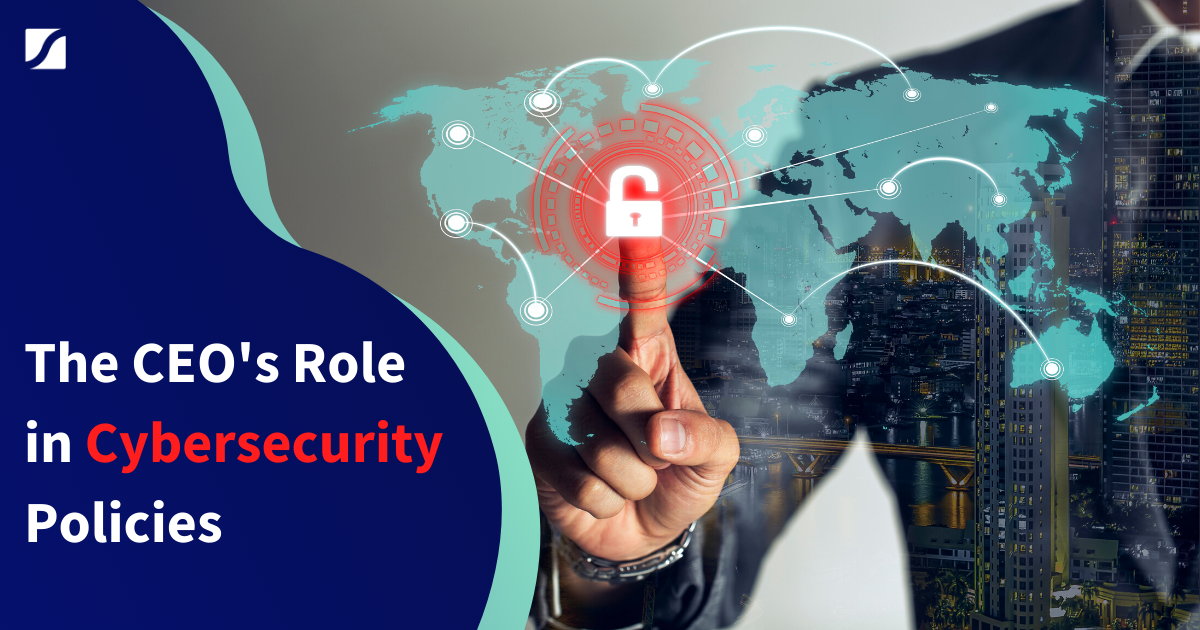The CEO's Role in Cybersecurity Policies

If you’ve been following news around large companies and cybersecurity lately, you may have noticed the increased amount of data breaches many companies are experiencing.
Microsoft, Facebook, and T-Mobile are a few big corporations that have encountered big data breaches that exposed millions of users’ information. For example, Microsoft recently exposed over 250 Million customer service records due to a faulty security system. With this in mind, CEOs have been on high alert to make sure that this type of tragedy doesn’t happen to their companies as well.
In a modern business model, CEOs don’t necessarily have full control of their companies’ cybersecurity policies and practices. Yet, when data breaches happen, it’s the CEOs that are often blamed for not being cautious enough. Even though it might be a faulty security issue, or your company was strategically targeted by cybercriminals, the CEO often gets the fault when there’s no one else to blame.
To help make sure your company doesn’t experience any data breaches that would affect your bottom line, here are a few ways you, as a CEO, can play a role in your company’s cybersecurity.
Understand the Fundamentals of Cybersecurity
It’s not possible for the CEO to know everything about cybersecurity.
If you, there would be no need for the expertise of your IT team. However, you should have some base-level knowledge about cybersecurity and your company’s cybersecurity policies. In order for you, as a CEO to be on the right side of cybersecurity, it’s important to take a personal approach and understand some basic fundamentals of this area.
Knowing the terms of cyberthreats that could possibly affect or cause a data breach is important. For example, most of us might know what phishing tactics are, but not everyone will know what a spear-phishing tactic is. While phishing emails are mass emails sent to multiple Internet users, spear-phishing emails are specifically tailored to one specific person. Knowing the difference between the two can help when it comes to providing insight in dealing with these issues.
While many CEOs rely on their IT team to relay this information, it’s best to know what these terms mean ahead of time so you can properly provide insight as part of the administrative leadership. It’s also important that your employees know these terms and are properly trained on cybersecurity protocol. Reading through websites like PCMag can help you keep up on the newest trends and terms.
Implement the Proper Software
When many of your company processes rely on digital systems, minor mistakes can be costly.
Something as simple as opening the wrong email or clicking an unsafe link has the potential to cause a huge financial setback.
That’s why it’s important to have software in place that helps catch mistakes when they happen. This will help ensure that even though your team might be up to date on the best practices, you have software in place that can catch whatever slips through the cracks.. Fortunately, there are many different types of cybersecurity software that your company can implement throughout your staff’s devices.
Using software suites is a great way to ensure you have all your bases covered. However, there are a few systems that could really make an impact. Cybersecurity software, like virtual private networks, is a great example of the traditionally atypical software you can implement. According to NortonLifeLock, VPNs can make a public connection private by hiding a device’s IP address.
So, say a remote employee connects to a public Wi-Fi network. Cybercriminals on that Wi-Fi are just waiting for unsecured devices to connect. They can hack into unprotected devices to steal personal information. If one of your staff members has a VPN, their device is undetectable and thus safe from cybercriminals.
Knowing about software like this can be a game-changer for companies that have a lot of remote employees. To make sure you’re implementing the best program for your company’s needs, make sure you research multiple types of antivirus software.
Be Involved in Writing Policies
Due to the mass amount of cybersecurity threats businesses are facing these days, companies are writing all-encompassing cybersecurity policies to be prepared. That way if there were ever a cyber threat or a data breach, everyone has guidelines for how to properly handle the situation.
As the CEO of your company, you should be heavily involved in writing this policy.
The first step in doing so is to understand the type of network security your business already has implemented. You might know what types of systems you have installed, but do you have a base knowledge of what your software really does for you? There could be a chance that you have antivirus software, but that doesn’t always mean it’s all-encompassing to include anti-malware, VPNs, firewalls, or deep web monitoring. A good way to make sure you have the correct information about your security software is to meet with your IT department, who can fill you in on your security software’s abilities.
From there, decide if you would like to implement concepts like software standardization, limited access, or two-factor authentication security, to help bring your standard cybersecurity to the next level. To learn more about these standardizations and how to know if your company needs them, you can learn more from the Federal Communications Commission and the resources they provide for small businesses.
In these cybersecurity policies there should be a standardized way of using technology to avoid dangers. Consider mentioning types of emails to avoid. Also, include which people in the company are accountable for action plans. This is important to know when there is an information leak.
Most of all, you should make sure that the employees are seen as the most important people in the policy document and that they see it as a guideline to follow. As the front lines of the company on the Internet, your employees need to know the best practices for keeping your information secure.
Company Security Is An Investment
It takes dedication to be able to make cybersecurity a priority as a CEO. With a mindset change to instead see security as an investment, you will be able to seamlessly consider the protection of your company in every decision you make. In doing so, you will protect your brand and the success of your business.




